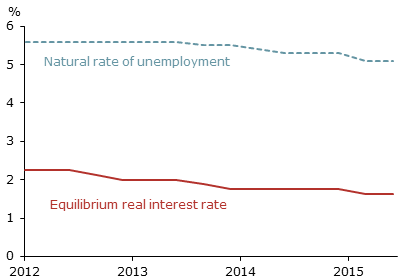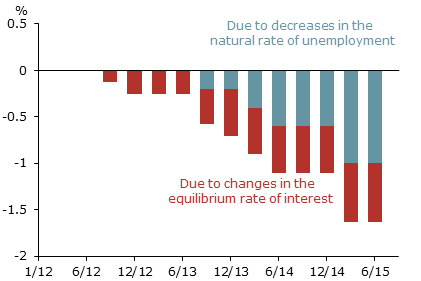Over the past several years, the Federal Open Market Committee’s longer-run forecasts of the short-term interest rate and unemployment rate have steadily declined. These forecasts reflect the Committee’s views about the levels of the policy interest rate and unemployment rate that will eventually prevail when the economy returns to normal. A simple monetary policy rule illustrates how the reductions in these forecasts can imply a lower projected path for the policy rate.
The Federal Open Market Committee (FOMC) has signaled that—if economic conditions continue to improve—it could soon begin the process of normalizing the stance of monetary policy. As it does so, it will need to judge what normal looks like. In particular, one popular rule-based policy measure would require the FOMC to quantify the natural rate of unemployment and the equilibrium real interest rate in order to calibrate appropriate policy. These longer-run rates are difficult to pin down and most likely changed in the aftermath of the Great Recession. In this Economic Letter, we use the evolution of the FOMC’s longer-run forecasts to infer its changing views on the natural and neutral rates. We then use a simple monetary policy rule to show how such changes can affect the duration of accommodative monetary policy and the eventual longer-run setting of policy.
The equilibrium real interest rate and the natural rate of unemployment
The natural rate of unemployment and the equilibrium real interest rate, also called the natural rate of interest, are two long-run rates that are important to the conduct of monetary policy. Both are conceptual constructs meant to summarize conditions when the economy is in equilibrium or normal times. The natural rate of unemployment is the unemployment rate that would occur in the absence of short-run business cycle fluctuations, when the economy is operating at full employment. Analogously, the equilibrium real interest rate is the short-term interest rate, minus inflation, that would occur when inflation is steady and the economy is growing at its potential. The drivers of the natural rates of unemployment and interest are slow-moving structural factors such as demographics and technology.
Since natural rates cannot be observed, they must be estimated using statistical or modeling techniques. In general terms, both methods attempt to pull out low-frequency or slow-moving trends in the data from those associated with higher-frequency cyclical variations. Purely statistical techniques rely on different data filtering methods to make these separations. Modeling techniques focus on incorporating data into representations of the economy that account for factors such as changes in supply and demand and the reaction of prices in order to estimate the natural rates of unemployment and interest (for example, Laubach and Williams 2003 and Curdia et al. 2014). Since each approach requires assumptions, forecasters and policymakers usually draw on estimates from a variety of sources to project natural rates.
Recent views from the FOMC
Four times a year the FOMC participants write down their views regarding the evolution of the economy, including projections of the long-run values of unemployment and the nominal rate of interest. The Fed publishes a summary of these views—the Summary of Economic Projections or SEP—along with the FOMC statement. We use this summary to document in Figure 1 the evolution of the FOMC participants’ views on the natural rates of unemployment and interest over the past 3½ years, from January 2012 through June 2015. We use the SEP projections for the long-run unemployment rate as the natural rate of unemployment and the long-run nominal interest rate, minus long-run inflation, as the natural rate of interest. The figure displays the mean of the central tendency, a measure that excludes the three highest and three lowest projections; for simplicity, we call this the average projection for the remainder of this Letter.
Figure 1
Declining estimates of natural rates

Source: Summary of Economic Projections.
The figure shows that FOMC participants have steadily lowered their estimates of the natural rate of unemployment and the natural rate of interest over the past several years. In June 2013, the average participant believed the natural rate of unemployment was 5.6% (blue dashed line). That average now stands at 5.1%, a 0.5 percentage point drop. Similarly, the average SEP estimate of the equilibrium real interest rate (red solid line) declined from 2.25% in January 2012 to 1.63% in June 2015, more than a 0.6 percentage point drop. Given how slowly the variables that determine the natural rates of unemployment and interest move, these declines are significant.
Notably, the declines in the natural rates pictured in Figure 1 are not unique to FOMC participants. Similar declines can be seen in other public- and private-sector forecasts, as well as market-based measures (Leduc and Rudebusch 2014 and Williams 2015). Although individuals may have particular views on what is behind the declines, there is growing recognition that changes in population growth and population composition—in particular the aging of the population—are important drivers.
Policy implications of declining natural rates
To illustrate how changes in the natural rate of unemployment and the equilibrium real interest rate can affect monetary policy prescriptions we use a simple rule proposed by Taylor (1999). In this rule, the policy interest rate is set by the equilibrium rate of interest plus or minus adjustments associated with the deviations of inflation from its target—the inflation gap—and the deviations of unemployment from its natural rate—the unemployment gap. The reaction of policy to these deviations is given by the coefficients or numerical multipliers on the inflation and unemployment gaps, which are frequently estimated to be 0.5 for inflation and 2 for unemployment. A simple version of the rule can be written as:
| Target policy rate = | equilibrium real rate of interest + inflation + (0.5 × (inflation – target)) |
| – (2 × (unemployment – natural rate of unemployment)). |
This rule demonstrates how changes in the natural rates can affect policy. When the equilibrium rate of interest falls, the target policy rate will fall, holding the inflation and unemployment gaps constant. Similarly, holding the natural rate of interest and the inflation gap constant, a lower natural rate of unemployment also implies a lower target policy rate. Based only on this simple rule, the decline in the FOMC participants’ views on the long-run rates of interest and unemployment could be expected to put downward pressure on the path of policy.
To quantify how the changes in the SEP estimates show through to changes in the policy rate as given by Taylor (1999), Figure 2 plots the decline in the rule-based policy rate broken down into the influences of the natural rate of interest (red) and the natural rate of unemployment (blue). The changes are relative to the rates computed from the January 2012 SEP.
Figure 2
Components of lower rule-based policy rates

Note: Bars show differences in rule-implied rates based on SEP long-run estimates relative to January 2012 SEP estimates.
For example, in March 2014, the average estimate of the two natural rates implied a policy rate that was 0.9 percentage point lower than the policy rate using the January 2012 estimates. Concretely, the average estimate of the natural rate of unemployment was 0.2 percentage point lower and the average estimate of the natural rate of interest was 0.5 percentage point lower. Using these numbers in our simple policy rule indicates that the decline in the natural rate of unemployment would translate to a 0.4 percentage point decline in the policy rate implied by the rule, and the decline in the equilibrium real interest rate would translate to a 0.5 percentage point decline in the rule-based policy rate.
In the most recent period, the June 2015 estimates of the natural rates of unemployment and interest imply a policy rate 1.6 percentage points lower than it would have been based on the January 2012 SEP averages. Decomposing this total decline shows that about three-fifths relates to the decline in the natural rate of unemployment and two-fifths to the decline in the natural rate of interest. Over time, the adjustments to the natural rate of unemployment have contributed more to the decline in the policy prescription.
Of course, simple rules like the ones we apply here cannot fully capture the process of decisionmaking at the FOMC. However, the prescriptions from the simple rule illustrate the connection between natural rates and policy rates and show the sensitivity of policy to views on these values.
Conclusion
In this Letter, we document the decline of FOMC participants’ estimates of the equilibrium real interest rate and the natural rate of unemployment based on the Summary of Economic Projections. These long-run rates are important for policymakers when determining both the current conduct of and the future path for monetary policy. A simple monetary policy rule shows that, compared with earlier projections of these rates, declines in the natural rate of unemployment could translate into a longer period of accommodative monetary policy and declines in the equilibrium real interest rate could translate into a lower average policy rate in the long run.
Mary C. Daly is a senior vice president in the Economic Research Department of the Federal Reserve Bank of San Francisco.
Fernanda Nechio is a senior economist in the Economic Research Department of the Federal Reserve Bank of San Francisco.
Benjamin Pyle is a research associate in the Economic Research Department of the Federal Reserve Bank of San Francisco.
References
Curdia, Vasco, Andrea Ferrero, Ging Cee Ng, and Andrea Tambalotti. 2014. “Has U.S. Monetary Policy Tracked the Efficient Interest Rate?” FRB San Francisco Working Paper 2014-12.
Laubach, Thomas, and John C. Williams. 2003. “Measuring the Natural Rate of Interest.” Review of Economics and Statistics 85(4, November), pp. 1,063–1,070.
Leduc, Sylvain, and Glenn D. Rudebusch. 2014. “Does Slower Growth Imply Lower Interest Rates?” FRBSF Economic Letter 2014-33 (November 10).
Taylor, John B. 1999. “The Robustness and Efficiency of Monetary Policy Rules as Guidelines for Interest Rate Setting by the European Central Bank.” Journal of Monetary Economics 43(3), pp. 655–679.
Williams, John C. 2015. “The Decline in the Natural Rate of Interest.” FRB San Francisco manuscript, forthcoming in Business Economics.
Opinions expressed in FRBSF Economic Letter do not necessarily reflect the views of the management of the Federal Reserve Bank of San Francisco or of the Board of Governors of the Federal Reserve System. This publication is edited by Anita Todd and Karen Barnes. Permission to reprint portions of articles or whole articles must be obtained in writing. Please send editorial comments and requests for reprint permission to research.library@sf.frb.org
